Print books vs e-readers: What’s the most sustainable way to read a book?
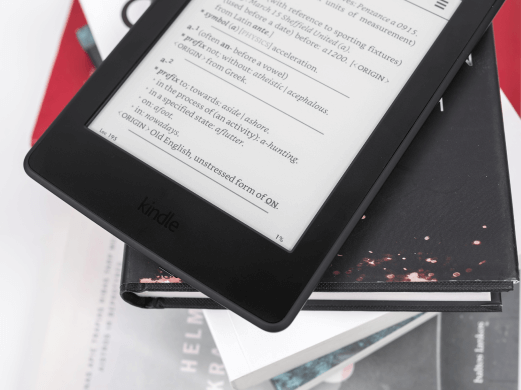
Should you stop buying print books and consider switching to an e-reader? To celebrate International Book Lover’s Day, we’ve put together some figures to help you make your eco-conscious decision.
We include products we think can be useful for our readers. If you make a purchase through the links on this page, we may earn a small commission.
For most people, August 9 is just a regular day, but for some, it’s a day when we put away our smartphones, open a good book and dive into reading. If you haven’t guessed yet, August 9 is National Book Lover’s Day.
We invite you to celebrate this day with us by learning what is the environmental impact of your favourite way of reading. We’ve studied different reports and research and collected the most important data that defines the sustainability of paper books and e-readers. Some years ago there were published several studies that basically stated that the future of reading is with e-readers. But is that really so? With the help of a simple math equation, we will show you that an e-reader might not be the most sustainable solution for you. Let’s start by exploring the most important figures first.
Electronic readers versus print books
Every product has its life cycle stages, in the case of books (electronic and paper) those are as follows: supply of materials, manufacturing, transportation, reading and disposal. In the table below, we compare the ecological impact of every life cycle stage for both types of books.
| Print book | E-reader |
| Supply of materials | |
| A book made of recycled paper needs around two-thirds of a pound of minerals. Mostly gravel, which is used to build roads to transport materials in the supply chain. | To produce one e-reader, the extraction of 33 pounds of minerals is required. A mineral like columbite-tantalite is used to manufacture the reader itself when sand and gravel are usually needed to build a landfill and hold the production waste. |
| For a traditional book, the manufacturer needs two gallons to make the pulp slurry that is later pressed and dried under high temperatures to create paper. | An e-reader requires 79 gallons of water to produce batteries, wiring and to refine needed metals. |
| Manufacturing | |
| 2 kWh (kilowatt hours) of fossil fuels are needed to form and dry the sheets | 100 kWh of fossil fuels are used to manufacture one e-reader. E.g. the daily average electricity usage in the UK home is 8-10 kWh. It means that you can power your home for up to 10 days with the energy used to manufacture one e-reader. |
| The carbon footprint of a single book is approximately 1.2 kg to 7 kg CO2. Depending on how big the book is and if its cover is soft or hard. | According to different sources, CO2 emission produced while manufacturing one e-reader varies between 29 and 168 kg. |
| The negative impact on our health is caused by emissions of nitrogen and sulfur oxides. These substances deeply enter our lungs, causing worsening asthma, chronic coughing and increasing the risk of premature death. | Both e-readers and books contribute to emissions of nitrogen and sulfur oxides. With the significant difference that from making one e-reader the estimated amount of harmful emissions is around 70 times greater than those from making a single book. |
| Transportation | |
|
Long-distance delivery (500 miles or more) of the book can create equal pollution and amount of waste as making the book in the first place. Driving five miles to the bookstore and back can be ten times more harmful to the environment than producing a book. |
To match a toxic impact on health appearing from making one e-reader, you’d need to drive to a store 300 miles away. |
| Reading | |
| Reading a book for an hour or two during the dark time of the day with a light bulb on will use more energy than it takes to charge an e-reader. However, if you’ve already switched to LED bulbs or read in daylight, the advantage is on a book’s side. | E-readers are extremely energy-efficient thanks to their black-and-white e-ink displays. You can go on reading for weeks on a single charge if you’re spending one hour a day reading. |
| Disposal | |
| A single book in a landfill with its decomposition generates double the global warming emissions and toxic impacts on local water systems as its whole manufacturing. | If your e-reader ends up being “recycled” illegally in one of the developing countries, workers will be exposed to the toxic impact of some dismantled substances. This therefore can cause multiple health issues and increase the risk of premature death. Don’t forget that child labour is a common thing in some countries and contact with toxic parts can cause some irreversible health issues at a very young age. |
Sources: VTT Technical Research Centre of Finland, The New York Times, The Guardian, Rolling Stone
So what is the approximate equivalent of one e-reader in books by the above-mentioned emissions and resources? Here is the equation:
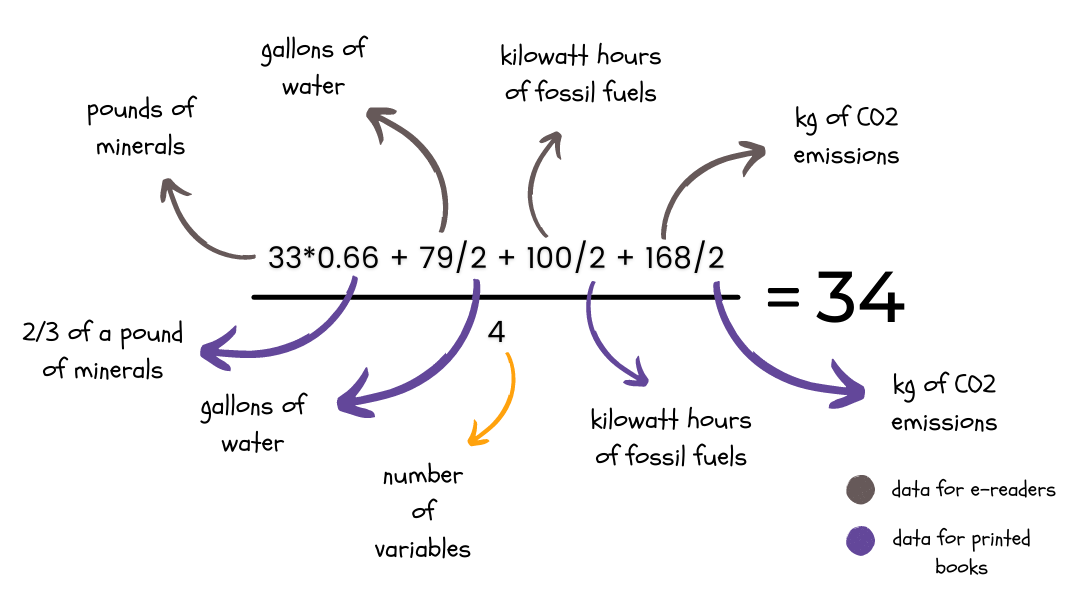
Meaning that 34 books can be produced and have the same environmental impact as manufacturing one single e-reader. And we don’t add here any health-related numbers or the impact of global warming. This already seems like an obvious yes for books, but actually, if you read more than 30 books a year, you should definitely consider buying an e-reader. This way you will make a one-time investment into a gadget that will last you for years and after a year of use, your reading emissions will be cut to the minimum.
Is it cheaper to read ebooks?
Ebooks are usually cheaper than printed books. See our book recommendations on sustainability below, in some cases for an ebook you will pay one-fourth of what you’d need to spend on a traditional book. The additional advantage, there are official portals where you can download some titles for free. But you need to count on initial investment into the device itself. The prices of an e-reader can start from as little as £60 and cross the point of £200. If you decide to buy one for yourself, be sure you check on discount codes or shop via cashback links, to knock some money off your order.
Sustainability tips for print and e-book readers
We believe that these numbers in the table are improving significantly, as new technologies, certifications and opportunities are being introduced. For instance, book publishing giants like Penguin and Macmillan have already made commitments and first steps towards a sustainable future. They try to be more efficient in different aspects and even create dedicated teams to tackle environmental problems. Penguin has made a promise to become carbon neutral by 2030 and only use paper that is FSC-certified (Forest Stewardship Council™).
Macmillan claims that most of its printer-supplied paper is already FSC-certified, plus it also tries to improve its energy efficiency in the UK by switching to renewable power sources as well as encourages eco-lifestyle among its employees. Additionally, some publishing houses are switching to vegetable-based inks and choosing to make book covers from eco-friendly materials.
When it comes to electronic devices, it’s much harder to evaluate this change for the better, as the production cycle is much more complex. We’re sure there are positive changes and the emissions are getting lowered as manufacturers are becoming more energy-efficient, then they also learn how to better recycle their devices and cause less harm to the planet. We’ve found an amazing guide created by The Ethical Consumer, the UK's leading alternative consumer organisation, which evaluates and ranks e-reader and tablet brands for their ethical and sustainability efforts. Take your time to analyse the scores and methodology if you think that e-reading is your go-to option. We were surprised that the most popular e-reader, Kindle, scored 0 out of 20 points.

Remember, whatever your chosen best way of reading is, there is always a possibility to do things better. You don’t need to buy a Kindle if you love reading paper books, as well as you don’t need to give up your e-reader if you’re all the time on the go and can’t carry a bag of books with you.
Green tips for printed book lovers
- Join the libraries. This is your greenest option if you don’t need to drive long to your nearest library. Thousands of good reads will be available to you at any time, plus you’ll save on the book prices.
- Buy second-hand. Extend the life of books, buy used books online or in charity shops. Also resell your books, unless you re-read them all the time. Who likes cleaning the dust on the shelves all the time?
- Join book clubs. Can’t imagine life without reading? Meet the like-minded and get to discuss the classics as well as modern authors with a cup of tea.
- Buy books made of recycled paper. You will ask how to make sure a book is made of recycled paper. Look for the FSC seal on the cover or inside the book. It looks like a small tree and guarantees that the book is printed on recycled paper.
- Donate books to relevant charities. Marie Kondo your house, get rid of all the stuff you don’t need, including books that you don’t read. But “get rid” in an eco-friendly way - research which charities near you accept books and bring them there when you have time. Don’t put out your books on the street hoping someone will take them. With the first rain, they will lose their shape and quality, and then will finally end up in a landfill, and the goal is different.
- Participate in book swaps. Have you seen those small bookshelves on buses? Great, now take your books one by one and give them another bus life. Someone might like the title and take it for a read, as well as you can find an inspiring novel to devour tonight.
- If you read more than 30 books a year, consider investing in an e-reader. You’ve seen the math above, the decision is after you.
Green tips for the e-reader lovers
- Treat your device nicely so it lasts you longer. Try being responsible rather than following a modern trend and upgrading your e-reader every year. A typical e-reader should last you around four years, but if you’re a careful owner, it can serve you even for up to eight years.
- Resell/donate/gift it if you don’t need your e-reader anymore. Try to extend your device’s life by giving it to someone who might still use it.
- Try to fix it before buying it new or throwing away. E-readers have one common weak point - it’s an e-ink screen. You will be surprised that those can be easily replaced by specialists for no more than 30 quid.
- Tablet vs e-book. Both devices look similar, the direct purpose is slightly different though. If you have both, we recommend reading on an e-reader, this will cut your electricity consumption as well as your eyes won’t get tired that fast.
- Miss the feeling of opening a freshly-printed book? We’ve got you! If you need that feeling of crispy pages on your fingers and a smell of fresh ink - buy a Biblichor Scented Candle, it will help you create the atmosphere.
- Recycle. Last but not least - always recycle your dead devices responsibly. All electronic device manufacturers are obliged to support their customers with recycling of their products. If this is too much hassle, you can also choose to bring your dead device to one of the nearest recycling centers.
5 top-pick books on sustainable and eco-friendly living
You’ve heard the buzzwords climate change, climate crisis, global warming, environmental pollution, etc. Unfortunately, these words are there to stick for a long time with us being lazy or unwilling to change our habits. Since we’re here on the topic of reading, we thought it would be good to list some books that will help you be more eco-conscious in different aspects of your life. There are many approaches to sustainability, and it doesn’t matter which one you choose to adopt. The important thing is that you start doing something, whether that’s a composter on your terrace or going vegan - pick an idea you think you’re ready to commit to and the books below will be there to inspire and support you on your journey to a more sustainable living.
1. Falter: Has the Human Game Begun to Play Itself Out?
Author: Bill Mckibben
Goodreads rating: 4.05 out of 5
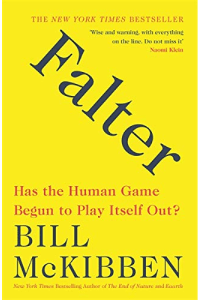
Three decades ago, American author Bill McKibben offered one of the earliest warnings about climate change. With this book he broadens the warning, arguing that humans are risking playing themselves out because of being in between two biggest threats: ecological destruction and technological overreach. In the book you will find many examples, facts and statistics marshaled not to frighten you, but to deliver the message of the severity of the current situation. He also calls to action and even suggests some possible ways to save our future.
Get your print book or an ebook copy
2. How to Avoid a Climate Disaster: The Solutions We Have and the Breakthroughs We Need
Author: Bill Gates
Goodreads rating: 4.2 out of 5
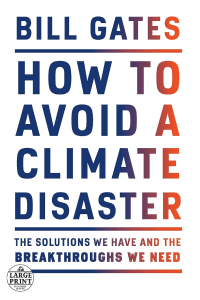
Bill Gates has spent years investigating the causes and effects of climate change and invested millions in the development of interesting ideas and projects. In his book, he makes a logical order of data and describes our future scenarios. He makes it clear: the solution is not in the individual fixes, but in the global plan that is deeply connected to the economy and politics. He believes that the future is in technology which already plays a major role in reducing our impact on climate. In the end, the author proposed an innovative, concrete, practical plan for achieving the goal of zero emissions and explained how we can support and control our governments in reaching it.
Get your print book or an ebook copy
3. How Bad Are Bananas? : The carbon footprint of everything
Author: Mike Berners-Lee
Goodreads rating: 3.86 out of 5
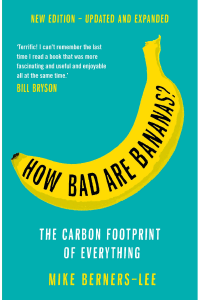
A book by a British researcher and writer on the topic of carbon footprinting. His book was a breakthrough in common myths once first published in 2009. He explains the carbon impact of things we use every day (cars, books, plastic bags, etc), the global (tourism, aviation, deforestation, sports events, data centres, etc) as well as in the new edition covers social media, cryptocurrency, space tourism and more. If you think that’s a two-hundred-page list of the carbon footprint figures of different items we use, you’re seeing just one side of the coin. The goal is to open our eyes regarding some things we never thought could be harmful. The author put together the information, so we, readers, can manage our carbon footprint better.
Get your print book or an ebook copy
E-book
4. How To Break Up With Fast Fashion
Author: Lauren Bravo
Goodreads rating: 4.31 out of 5
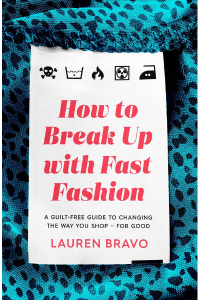
Did you know that global clothing production has roughly doubled in just 15 years, and every year an estimated 300,000 tonnes of used clothing ends up in a UK landfill? Fast fashion together with our lack of understanding of how to wisely shop has led to those frightening numbers. This toxic relationship must break and journalist Lauren Bravo's book is there to help you. She went through the change herself and like no one else can help you change your mindset about clothing. The book is full of honest and realistic advice, it will inspire you to repair, recycle and donate your unwanted clothing without sacrificing your style.
Get your print book or an ebook copy
5. The Sustainable(ish) Living Guide: Everything you need to know to make small changes that make a big difference
Author: Jen Gale
Goodreads rating: 4.24 out of 5
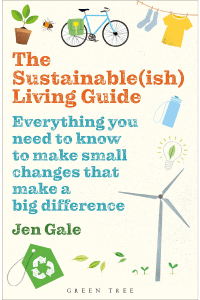
Easy, practical, down-to-earth ideas and suggestions for everyone to help save the planet. If you want to learn more about what you can do here, this book can become your real guide. The author covers pretty much every aspect of our lives from the regular shopping routine and the food habits, to how we travel, work, and celebrate. The book provides us with realistic and doable ideas to introduce into our lives, alongside a gentle kick up the butt to act upon your new knowledge. Have you ever thought about overfilling your kettle and therefore paying more for electricity? No? Neither do we, but apparently, British households overpay GBP68 million on energy bills each year due to such a trivial reason. Find out what works for you and start taking one step at a time towards a greener life.
Get your print book or an ebook copy
Pick one of these great books on sustainability and get started! We believe if every one of us reads any of these books and embraces some ideas, we really stand a chance to save our planet. And by choosing your sustainable way of reading, you contribute to even greater change. Don’t be afraid to make mistakes though, we’re all humane and it’s ok to forget your reusable coffee mug at home. Remember, one small step at a time.